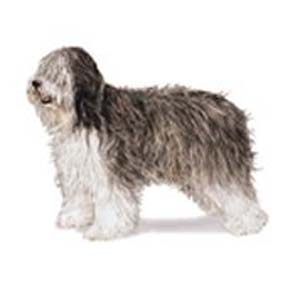Polish Lowland Sheepdog Breed Standard
General Appearance
Medium-sized, cobby, strong and muscular, with a long, thick coat and hanging hair that covers the eyes. His herding and working ability is attributed to an intense desire to please and compatible nature. He is lively but self-controlled, clever and perceptive and well known for an excellent memory.
Size, Proportion, Substance
Well balanced due to a strong skeleton. Height measured at the withers for an adult dog is 18 - 20 inches, and 17 - 19 inches for a bitch. It is not desirable to diminish the size below the Standard, making the dog too delicate for a  strong working dog. The silhouette is rectangular rather than square. The ratio of height to length is 9 - 10, meaning that the height at the withers should equal 9/10ths of its length. Fault: Long legs. strong working dog. The silhouette is rectangular rather than square. The ratio of height to length is 9 - 10, meaning that the height at the withers should equal 9/10ths of its length. Fault: Long legs.
Head and Skull
The medium-sized head is in proportion to the body. The profuse hair on the forehead, cheeks and chin make the head look bigger than it actually is. Expression should be lively with a penetrating gaze. Eyes are of medium size and oval. Fault: Protruding eyes. Colors are brown or hazel. The edges of the lids are as dark as possible within the coat color. Ears are heart-shaped, drop, and set moderately high. Fault: Ears set too high. They are medium size in proportion to the head and should be fully covered with long hair. Skull is moderately broad and slightly domed. The forehead furrow and occiput are palpable. The stop has a pronounced indentation, but never as pronounced as a round-skull breed. Fault: A round head, apple shaped head. The ratio of muzzle to skull is 1:1. A little shorter muzzle is acceptable. The topline of the muzzle is straight. Fault: Convex or concave muzzles. The jaws are strong. Teeth a full compliment of strong white teeth meet in a scissors or level bite. Nose should be large and black or brown, depending on the coat color. A pink nose or a nose partially lacking pigment should be penalized.
Neck, Topline, Body
Neck is muscular and strong. It is broad, without dewlap and held horizontally when moving. Faults: Neck held too high or too narrow. The back should be neither too long or too short for proper balance and movement. Withers are well pronounced and broad. The chest is deep and broad. The topline is level. The loin is well muscled and broad. The croup is slightly cut, but only to a small degree. The belly is slightly drawn up. Tail should be short, set low and no longer than two vertebrae. It should not change the shape of the body. Tails are docked on puppies born with long or partial tails.
Forequarters
The shoulders are heavily muscled, and well laid back at an angle of approximately 45°. A line drawn from the highest point of the shoulder blade to the forward point of articulation approximates a right angle with a line from the forward point of articulation to the point of the elbow. The legs are straight and vertical, with heavy bone. The pasterns are flexible without weakness. The feet are oval, thick and compact, with the front feet larger than the rear feet.
Hindquarters
Large, heavily boned, and well muscled. Hocks are parallel when viewed from the rear. Fault: Cowhocks. Feet are oval with tight arched toes. Pads are hard. Nails are dark.
Coat
It is doubled coated. The entire body is covered with a long, dense, shaggy, thick coat that is reasonably straight. The undercoat is soft and dense. Characteristically, long hanging hair covers the eyes. A slight wavy coat is acceptable. Faults: A curly coat, lack of undercoat and short coats. The Polish Lowland Sheepdog must be shown naturally -- no scissoring is allowed.
Color
All coat colors are acceptable. The most common colors are white with either black, gray or sandy patches and gray with white, or chocolate. Most carry a dominant fading factor genetically, which results in puppies being born darker in coat color than they will appears as adults, with the exception of those puppies born white.
Gait
The gait is fluid motion. He is often an ambler. With the correct shoulder angulation, he is capable of swinging his front legs forward with great reach of stride, extending out before his body in a long flat arch. The stride propels the body forward, rather than upward, with less fatigue. When viewed from the front, the legs should move parallel from the elbows to the pasterns. Toeing in is considered natural. Fault: Toeing out. The greatest source of his forward drive is derived from good rear angulation. When viewed from behind, the back legs should be parallel to each other and not too close. Fault: Close rear movement.
Temperament
He is stable and self confident. He needs a dominant master and consistent training from the time he is very young. If this is not provided, he will tend to dominate the master. When not used as a herding or working dog, he can be a magnificent companion as he seems to fit into any type of lifestyle. He is extremely loyal, but somewhat aloof and suspicious of strangers. Faults: Nervous, cowardly, or extreme vicious behavior.
Approved- January 11, 1999
Effective - July 1, 1999
|


 strong working dog. The silhouette is rectangular rather than square. The ratio of height to length is 9 - 10, meaning that the height at the withers should equal 9/10ths of its length. Fault: Long legs.
strong working dog. The silhouette is rectangular rather than square. The ratio of height to length is 9 - 10, meaning that the height at the withers should equal 9/10ths of its length. Fault: Long legs.